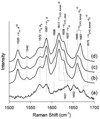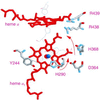Redox-linked transient deprotonation at the binuclear site in the aa(3)-type quinol oxidase from Acidianus ambivalens: implications for proton translocation
- PMID: 10449737
- PMCID: PMC22253
- DOI: 10.1073/pnas.96.17.9591
Redox-linked transient deprotonation at the binuclear site in the aa(3)-type quinol oxidase from Acidianus ambivalens: implications for proton translocation
Abstract
The hyperthermophilic archaeon Acidianus ambivalens expresses a membrane-bound aa(3)-type quinol oxidase, when grown aerobically, that we have studied by resonance Raman spectroscopy. The purified aa(3) oxidase, which does not contain bound quinol, undergoes a reversible slow conformational change at heme a(3) upon reduction, as indicated by a change in the frequency of its heme formyl stretching mode, from 1,660 cm(-1) to 1,667 cm(-1). In contrast, upon reduction of the integral membrane enzyme or the purified enzyme preincubated with decylubiquinol, this mode appears at 1,667 cm(-1) much more rapidly, suggesting a role of the bound quinol in controlling the redox-linked conformational changes. The shift of the formyl mode to higher frequency is attributed to a loss of hydrogen bonding that is associated with a group having a pKa of approximately 3.8. Based on these observations, a crucial element for proton translocation involving a redox-linked conformational change near the heme a(3) formyl group is postulated.
Figures





Similar articles
-
Active site structure of the aa3 quinol oxidase of Acidianus ambivalens.Biochim Biophys Acta. 2004 Apr 12;1655(1-3):306-20. doi: 10.1016/j.bbabio.2003.08.011. Biochim Biophys Acta. 2004. PMID: 15100046 Review.
-
Kinetics of electron and proton transfer during O(2) reduction in cytochrome aa(3) from A. ambivalens: an enzyme lacking Glu(I-286).Biochim Biophys Acta. 2001 Jan 19;1503(3):261-70. doi: 10.1016/s0005-2728(00)00195-x. Biochim Biophys Acta. 2001. PMID: 11115638
-
Dynamics of the binuclear center of the quinol oxidase from Acidianus ambivalens.Biochemistry. 1999 Aug 3;38(31):10032-41. doi: 10.1021/bi990473m. Biochemistry. 1999. PMID: 10433710
-
FTIR spectroscopic characterization of the cytochrome aa3 from Acidianus ambivalens: evidence for the involvement of acidic residues in redox coupled proton translocation.Biochemistry. 2003 May 27;42(20):6179-84. doi: 10.1021/bi0205348. Biochemistry. 2003. PMID: 12755620
-
FTIR studies of internal proton transfer reactions linked to inter-heme electron transfer in bovine cytochrome c oxidase.Biochim Biophys Acta. 2004 Apr 12;1655(1-3):321-31. doi: 10.1016/j.bbabio.2004.01.007. Biochim Biophys Acta. 2004. PMID: 15100047 Review.
Cited by
-
Heme-heme communication during the alkaline-induced structural transition in cytochrome c oxidase.J Inorg Biochem. 2008 Mar;102(3):414-26. doi: 10.1016/j.jinorgbio.2007.11.004. Epub 2007 Nov 28. J Inorg Biochem. 2008. PMID: 18187199 Free PMC article.
-
Dissimilatory oxidation and reduction of elemental sulfur in thermophilic archaea.J Bioenerg Biomembr. 2004 Feb;36(1):77-91. doi: 10.1023/b:jobb.0000019600.36757.8c. J Bioenerg Biomembr. 2004. PMID: 15168612 Review.
-
The cytochrome ba3 oxygen reductase from Thermus thermophilus uses a single input channel for proton delivery to the active site and for proton pumping.Proc Natl Acad Sci U S A. 2009 Sep 22;106(38):16169-73. doi: 10.1073/pnas.0905264106. Epub 2009 Sep 10. Proc Natl Acad Sci U S A. 2009. PMID: 19805275 Free PMC article.
-
Critical structural role of R481 in cytochrome c oxidase from Rhodobacter sphaeroides.Biochim Biophys Acta. 2009 Oct;1787(10):1272-5. doi: 10.1016/j.bbabio.2009.05.006. Epub 2009 May 20. Biochim Biophys Acta. 2009. PMID: 19463779 Free PMC article.
-
Properties of Arg481 mutants of the aa3-type cytochrome c oxidase from Rhodobacter sphaeroides suggest that neither R481 nor the nearby D-propionate of heme a3 is likely to be the proton loading site of the proton pump.Biochemistry. 2009 Aug 4;48(30):7123-31. doi: 10.1021/bi901015d. Biochemistry. 2009. PMID: 19575527 Free PMC article.
References
-
- Anemuller S, Schmidt C L, Pacheco I, Schafer G, Teixeira M. FEMS Microbiol Lett. 1994;117:275–280.
-
- Schafer G. Biochim Biophys Acta. 1996;1277:163–200. - PubMed
-
- Zillig W, Yeats S, Holz I, Bock A, Gropp F, Rettenberger M, Lutz S. Nature (London) 1985;313:789–791. - PubMed
-
- Fuchs T, Huber H, Burggraf S, Stetter K O. Syst Appl Microbiol. 1996;19:56–60.
-
- Giuffre A, Gomes C M, Antonini G, D’Itri E, Teixeira M, Brunori M. Eur J Biochem. 1997;250:383–388. - PubMed
Publication types
MeSH terms
Substances
Grants and funding
LinkOut - more resources
Full Text Sources

